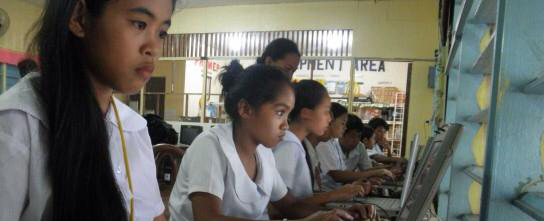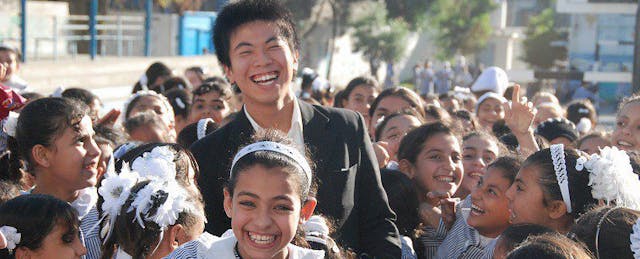When Atsuyoshi Saisho, spiky-haired and smiling, pulls out photographs and begins animatedly talking about his time spent in Bangladesh and Somaliland, you might expect the 25-year-old to talk about the travels of a curious university student. Instead, he explained the experiences of thousands of curious young people, now studying at universities across the world. By distributing instructional DVDs in remote areas, this young education entrepreneur has successfully helped thousands of students pass exams to enter university.
During an internship at the Grameen Bank in Bangladesh four years ago, Saisho noticed that many entrance exams prevented students in rural areas from entering university. While students in the capital, Dhaka, had access to prep courses, those far from the city had no academic support for the tests. Inspired by his success teaching himself material through online videos, Saisho recorded top test prep courses in Dhaka and brought the DVDs to students in rural villages in remote Bangladesh.
In the past four years, over 800 Bangladeshi students have used Saisho’s video instruction, called the e-Education Project. It makes a difference. A study from the University of Tokyo reported that 44% of students increased their chance of admission to university based on the instruction in Saisho’s DVDs, and Saisho reports that over 200 former students of the program have now matriculated at universities in Bangladesh.
Saisho has since expanded the program to three other sites: one each in Gaza, Jordan, and Rwanda. Unlike the Bangladesh program, these pilot programs provide instruction on more specific subjects, according to local interest. In Jordan, 20 to 30 students study for the university mathematics exam. In Rwanda, 200 to 300 students learn science. And in Gaza, 20 to 30 teachers learn about how to teach students with learning disabilities. “In Gaza City, there has been a huge amount of stress because of the bombings, so the rate of learning disabilities among students is very high,” Saisho explains. “But there’s no training for teachers there, so they don’t know any methods for helping those students.”
At each site, Saisho works with a local partner to ensure the video instruction is from the best instructors possible. To Saisho, that criteria includes observed classroom dynamics, student attitude and, most importantly, cultural understanding. This is especially key for students who hope to make a difference in their home communities. “If the student wants to continue education outside of Bangladesh, something like Khan Academy would have a big impact, but for students who hope to have an impact within Bangladesh, the best local teachers can have a much greater impact,” explains Saisho.
This fall, with a local partner, Saisho will launch a university and graduate program in Somaliland. The curriculum, which will largely focus on social innovation, will be taught 80% through video and 20% in person.
Saisho is winning fans. He was selected to participate in the Global Shapers Community, an initiative for young leaders sponsored by the World Economic Forum. While raising funds for his nonprofit venture in Silicon Valley last week, Saisho came by the office to visit EdSurgent Shu Uesugi and shared his perspective--and enthusiasm--with us.

EDSURGE: How did you get the idea for distance learning in Bangladesh?
SAISHO: In a Tokyo cram school [preparation for the notoriously rigorous Japanese national university entrance exams], I learned by teaching DVD content to myself. It worked very well for me. My cram school, Toshin High School, has over 800 branches all over Japan, and students in villages can also access the best teachers, by DVD or streaming. In Bangladesh, I met a lot of students, but [there was] a shortage of teachers. So I had the idea that Tokyo-style learning could apply in Bangladesh also.
Do you believe that distance learning works well for all students?
I think this kind of education works for students who want to study hard, for hungry students. I found that in Japan, 20 to 30 percent of students are very hungry for learning, maybe less. But in Bangladesh, I found it was much higher, more like 50 to 60 percent. Video learning can be applied for less driven students as well, but it needs to be driven by motivation. In Bangladesh, they have a real dream of learning and going to university. So this method worked very well.
If you had an opportunity to start your program in Bangladesh again, what would you do differently?
Our first year in Bangladesh, the instruction was free of charge for the students. Our second year, we tried to charge $30 from each village student. That was a total failure. No students came. In developing countries, with students that age, they don’t have a way to pay for education. That was a difficult time for us. Since then, we charge a little bit for the class, which has good impacts for attendance and concentration. But we decreased the price a lot.
Have you seen other young Japanese people get involved in education reform?
Now, there is a movement of Japanese youth going abroad, taking this business model and expanding it. We launched a nonprofit organization [the e-Education Project], and have a branch in Dhaka and in Tokyo. Japanese young people apply to take off the semester to go to a new place and begin a new program. So far, 12 students have applied to this model in nine countries, including the Phillippines, Cambodia, Sri Lanka, and Indonesia. Outside of Bangladesh, 1,200 students have been enrolled [in the pilot programs].

After your success with distance learning, why establish a university in Somaliland that relies on in-person instruction?
In Somaliland, the rich students leave to go to the States or England. Our university will focus on social innovation. We’ll try to collect the young, ambitious elite. Our vision is to have something like Y-Combinator there. I hope [the students in Somaliland] will also make some innovation and give back to their communities and make a good impact.
You emphasize finding teachers who share a cultural background with their students. Have you found that educators from different countries teach differently?
You know, bad teachers are bad teachers, all over the world. They have the same style. They don’t really see the student but just read out the textbook. Each country has very few good teachers, who are also very similar. They think about the student a lot, and focus on really interacting with the students, and engaging the student’s attention.
What’s your advice for others who want to reform education in developing countries?
Find a good partner, from the home country. And start small. Like [tearing down] a big wall: make a small hole, and start there.
In your programs, you encourage students to make a difference in their local communities. Do you plan to go back to Japan and change the educational model there?
I hope so. After reaching five continents. I’d like to challenge the traditional [Japanese] approach with a new model. My aim is a new kind of university, where rather than one professor teaching all, everyone becomes the professor. Everyone can teach and inspire each other, and make an impact. So my vision is totally opposite the Japanese system.
What was the biggest surprise you’ve encountered while setting up your programs?
In Somaliland, they eat camel meat. And it was delicious! So that was a big surprise.
Read about e-Education here. More on Saisho’s vision here (English) or in his TEDx talk here (Japanese).


